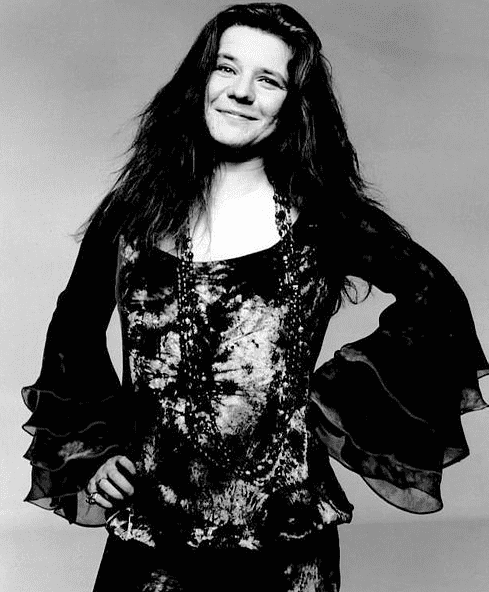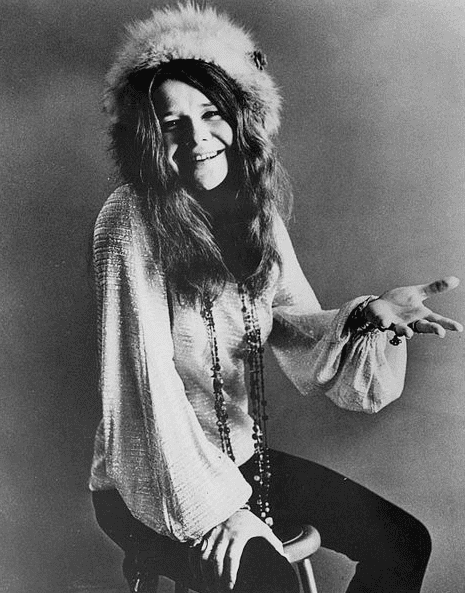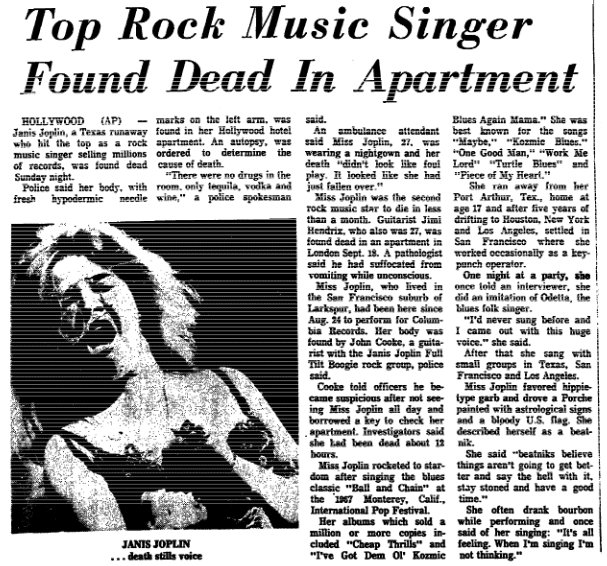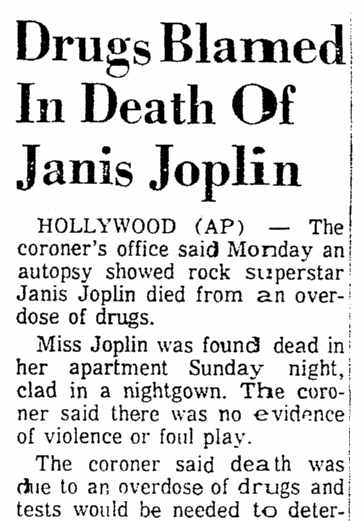Many questions surround the tragedy of Janis Joplin’s death. Idolized as a rockstar of her time, her life and career were cut short due to one unfortunate night. How old was Janis Joplin when she died? Where was she at the time of the incident? And what did Janis Joplin die of? This article uncovers details of her death and life through two historical articles.
Singer Janis Joplin’s life ended all alone, in a Hollywood hotel room, on 4 October 1970. So then how did Janis Joplin die exactly? Like Jimi Hendrix 16 days before her and Jim Morrison (of the Doors) 9 months after her, Janis died from drug and alcohol abuse – all three rock stars died at the age of 27. Specifically, in Janis’s case, it was a heroin overdose that killed her.

Although she’s an icon in rock and roll history, Janis’s career was remarkably short. She had been singing in small clubs for a few years, but she shot to prominence with her performance at the Monterey Pop Festival in June of 1967. She recorded four studio albums between 1967 and 1970, and then she was gone. In fact her fourth album, Pearl, was released posthumously.
Janis called herself a beatnik because “beatniks believe things aren’t going to get better and say the hell with it, stay stoned and have a good time.”

For the three years she was a rock superstar, Janis Joplin did just that. She lived hard and partied harder, and her powerful yet raspy voice reflected the rough edges of her life. Although she’s considered part of the rock ’n’ roll pantheon, her music – like her life – was grounded in the blues.
The following two newspaper articles are about Janis Joplin’s death. Both these articles cover the tragedy of Janis Joplin’s heroin overdose.

Here is a transcription of this article:
Top Rock Music Singer Found Dead in Apartment
HOLLYWOOD (AP) – Janis Joplin, a Texas runaway who hit the top as a rock music singer selling millions of records, was found dead Sunday night.
Police said her body, with fresh hypodermic needle marks on the left arm, was found in her Hollywood hotel apartment. An autopsy was ordered to determine the cause of death.
“There were no drugs in the room, only tequila, vodka and wine,” a police spokesman said.
An ambulance attendant said Miss Joplin, 27, was wearing a nightgown and her death “didn’t look like foul play. It looked like she had just fallen over.”
Miss Joplin was the second rock music star to die in less than a month. Guitarist Jimi Hendrix, who also was 27, was found dead in an apartment in London Sept. 18. A pathologist said he had suffocated from vomiting while unconscious.
Miss Joplin, who lived in the San Francisco suburb of Larkspur, had been here since Aug. 24 to perform for Columbia Records. Her body was found by John Cooke, a guitarist with the Janis Joplin Full Tilt Boogie rock group, police said.
Cooke told officers he became suspicious after not seeing Miss Joplin all day and borrowed a key to check her apartment. Investigators said she had been dead about 12 hours.
Miss Joplin rocketed to stardom after singing the blues classic “Ball and Chain” at the 1967 Monterey, Calif., International Pop Festival.
Her albums which sold a million or more copies included “Cheap Thrills” and “I’ve Got Dem Ol’ Kozmic Blues Again Mama.” She was best known for the songs “Maybe,” “Kozmic Blues,” “One Good Man,” “Work Me Lord,” “Turtle Blues” and “Piece of My Heart.”
She ran away from her Port Arthur, Tex., home at age 17 and after five years of drifting to Houston, New York and Los Angeles, settled in San Francisco where she worked occasionally as a key-punch operator.
One night at a party, she once told an interviewer, she did an imitation of Odetta, the blues folk singer.
“I’d never sung before and I came out with this huge voice,” she said.
After that she sang with small groups in Texas, San Francisco and Los Angeles.
Miss Joplin favored hippie-type garb and drove a Porche painted with astrological signs and a bloody U.S. flag. She described herself as a beatnik.
She said “beatniks believe things aren’t going to get better and say the hell with it, stay stoned and have a good time.”
She often drank bourbon while performing and once said of her singing: “It’s all feeling. When I’m singing I’m not thinking.”

Here is a transcription of this article on Janis Joplin’s cause of death:
Drugs Blamed in Death of Janis Joplin
HOLLYWOOD (AP) – The coroner’s office said Monday an autopsy showed rock superstar Janis Joplin died from an overdose of drugs.
Miss Joplin was found dead in her apartment Sunday night, clad in a nightgown. The coroner said there was no evidence of violence or foul play.
The coroner said death was due to an overdose of drugs and tests would be needed to determine the type.
Police called for an autopsy after saying they found needle marks on one arm. The autopsy surgeon reported numerous needle marks on both arms, with fresh ones on the left arm.
There was a small amount of alcohol but no evidence of barbiturates, ingredients of sleeping pills, the autopsy surgeon said, and no evidence of injury or violence.
The coroner also said a psychological autopsy, in which a team of behavioral scientists examines the subject’s personal life to determine whether a drug overdose was accidental or intentional, will be conducted.
“People seem to have a high sense of drama about me,” Janis Joplin once told an interviewer. “Maybe they can enjoy my music more if they think I’m destroying myself.
“I got into this because of something inside me. I’m not one of those people with a learned skill. If I’m going to do it I’m going to do it for real. I can’t just go out on stage and fake it. I’ve got to let loose with what’s inside.”
Her galvanic style brought her the title “the Judy Garland of rock.” She bore a resemblance to the previous star in her full-voiced style, her complete openness with an audience, and talk of self-destruction. Miss Garland died in a London apartment in 1969, apparently from a drug overdose.
Born in Port Arthur, Tex., in 1943, Janis Joplin was a rebel at an early age. She left home at 17, drifted across the country, taking odd jobs and occasional college courses. She came to admire beatniks because they “believe things aren’t going to get better and say the hell with it, stay stoned and have a good time.”
Fame overtook her at the 1967 Monterey Pop Festival. She had been singing in small clubs in San Francisco and Los Angeles, developing a mournful blues style that harked back to her early idols, Huddie “Leadbelly” Ledbetter and Bessie Smith.
At Monterey she astounded the huge audience with her vibrant style and depth of feeling on “Love Is like a Ball and Chain.” Her success was made.
Once she analyzed her style:
“Black people have the blues because they can’t have this and they can’t have that. Me, I was brought up in a middle-class family; I could have had anything. But you need something more in your gut, man.”
After Monterey came the trappings of superstardom – the shrieking crowds, constant travel, occasional brushes with the law over obscene language on stage. Janis Joplin was rich, but she still lived like a hippie in a cluttered San Francisco apartment.
Although she seemed totally fulfilled as an artist before the audience, she admitted that the rest of her life was wanting.
“The worst thing is the loneliness,” she told an interviewer last year. “Somehow you lost all the old friends. The travel circumstances pull them away.
“It’s hard to make new ones. When we’re not onstage, we rehearse, lay around in bed, check in and out of motels, watch television. It really is lonely. I live for that one hour on stage. It’s full of feeling. It’s more exciting than you’d expect in a lifetime. It’s a rush, honey.”
Related Articles:

There seem to be quite a few major discrepancies in this article. John Byrne Cooke who found her body was not a guitarist in her band Full Tilt boogie. He was her road manager and he wasnt suspicious all day, Janis Joplins album producer Paul Rothchild rang Cooke himself because Janis hadn’t turned up for her recording session. Also she was dead for 18 hours, not 12 when her body was discovered. Also Cooke stated he found her syringe and spoon in the beside drawer.
Thanks for these corrections, Howard. I obviously can’t change what the Trenton Evening Times published back in 1970, but your comments will help set the record straight for our readers. I appreciate you taking the time to read the article carefully, and commenting.
Janis Joplin completed the Pearl album and was not going to get a dime. Somebody, like her manager, was bleeding her dry. For years I thought she killed herself. Later reading the reports which say she had needle marks on her arm. She told me she never used the needle. She always took heroin in pill form. She was murdered by the music mafia. An old friend.
Thanks for writing, Michael. We all miss her as music fans, but you miss her as a friend — that’s much more special. Appreciate you sharing some thoughts with us about your old friend Janis.
Hi, I have to disagree. Sam Andrew, Janis’s band mate and off, on lover observed her, and he himself was an injecting heroin user. There are many instances of her shooting drugs, from her addiction to speed and methamphetamines, on her first visit to San Francisco in 1963. Many of her friends and lovers including James Gurley, Linda Gravenites, her road manager John Byrne Cooke and her boyfriend David Niehaus observed her injecting heroin and tried to stop her to no avail. Even the famous TV show host Dick Cavett called her out on her addiction. Her manager Albert Grossman even took out a life insurance policy on Janis he was so worried she would overdose by drugs. This is noted in a 1974 court case. I don’t believe that she was murdered by the music Mafia and I find it hard to believe she was being bled dry.
Interesting points, Howard. Thanks for writing and keeping the conversation going.